The SRTS Handbook is a comprehensive resource that is designed to help you and your SRTS team plan for an enduring SRTS project and program. If you are applying for a Major Grant, the handbook offers step-by-step modules for completing the Action Planning process. It can also be used to help plan your Mini-Grant programs. To download a PDF copy of the handbook, click here.
Welcome to Safe Routes to School
Safe Routes to School (SRTS) is a federal program to encourage and enable students to safely walk or bicycle to school. When routes are safe, walking or biking to and from school is an easy way to ease traffic congestion around schools while giving students the regular physical activity they need for good health and optimal school performance.
History of Safe Routes to School
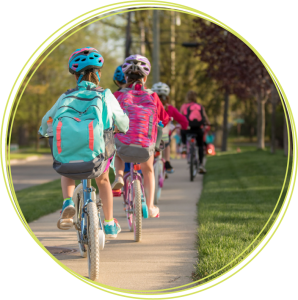 From 2003–2005 the Michigan Department of Transportation partnered with Michigan Fitness Foundation (MFF) to administer a Safe Routes to School pilot program at 11 elementary schools. The purpose of the pilot was to develop a set of materials and procedures that any Michigan elementary or middle school could use to begin its own SRTS initiative. When the pilot ended in 2005, the program was expanded statewide and made available to all Michigan schools, including charter, parochial, and private schools.
From 2003–2005 the Michigan Department of Transportation partnered with Michigan Fitness Foundation (MFF) to administer a Safe Routes to School pilot program at 11 elementary schools. The purpose of the pilot was to develop a set of materials and procedures that any Michigan elementary or middle school could use to begin its own SRTS initiative. When the pilot ended in 2005, the program was expanded statewide and made available to all Michigan schools, including charter, parochial, and private schools.
In 2005, the United States Congress authorized the first Safe Routes to School federal program and funding stream in the Safe, Accountable, Flexible, Efficient Transportation Equity Act: A Legacy for Users (SAFETEA-LU) transportation bill. These federal funds flow through the Michigan Department of Transportation (MDOT). Funding for eligible Safe Routes to School activities continued under the Moving Ahead for Progress in the 21st Century Act (MAP-21) of 2012, the Fixing America’s Surface Transportation (FAST) Act of 2015, and then a five-year transportation bill titled Infrastructure Investment and Jobs (IIJA) or Bipartisan Infrastructure Law in 2021. SRTS continues as a category of the Transportation Alternatives Program (TAP) with activities eligible for K-12 grades (formerly K-8). More information on the history and funding allocation of the SRTS program can be found on our History page or in the “SRTS Funding” appendix.
In Michigan, SRTS teams may apply for two kinds of funding: mini grant programmatic funds and major grant infrastructure funds. There is no required planning process for the mini grant funds which can be applied for by agencies other than the local transportation (Act 51) agency such as schools or nonprofit organizations. A team must complete the planning process outlined in this handbook before the Act 51 Agency would apply for major grant funds from MDOT.
Getting Started
While there are many ways that SRTS projects begin in Michigan, each project must follow criteria to develop a strong program which will be competitive to apply for funding. These criteria include the “Es” and the SRTS Michigan Planning Process. The planning process is a series of steps that the SRTS team takes to answer two questions:
- What are the obstacles to walking and biking to school?
- How do we diminish or eliminate those obstacles?
The Es: Engagement, Engineering, Encouragement, Education, & Evaluation
Easy to remember and to understand, the Es are used by SRTS partners to describe the wide range of steps in the planning process, the problems, and the solutions associated with walking and biking to school. When projects are developed with a combination of the Es, it increases the likelihood that a community will experience greater long-term success.
- Engagement looks for all Safe Routes to School initiatives to begin by listening to students, families, teachers, school leaders, and municipal staff and by working with existing community organizations and neighborhood residents to build intentional, ongoing engagement opportunities into the program structure.
- Engineering includes changes to the built environment that improve the safety of pedestrians and bicyclists (such as requesting zebra stripe crosswalks where students cross).
- Encouragement through activities, programs, and contests provides incentives for students to walk and ride to school. Activities also encourage communities to maintain Safe Routes to School for students such as rewarding parents who follow the school’s drop-off and pick-up rules.
- Education programs are primarily aimed at helping children build their walking, bicycling, traffic, and social skills but also include efforts to educate parents and other motorists. Education could include organizing SRTS assemblies that incorporate pedestrian and bicycle safety materials or having school staff incorporate safety into the classroom.
- Evaluation refers primarily to collecting data from students and parents to assess their behavior, beliefs, and attitudes towards non-motorized travel and to tracking the impact of SRTS projects. Evaluation allows SRTS to continually improve programs and to gauge impact. Evaluation tools include surveys, tallies, and audits during the action planning process, progress reports during implementation, and close-out surveys when you’re finished.
Resources and more extensive examples of each “E” can be found on our Getting Started page or in the “Completing an Action Plan” section of this handbook.
Overview of Michigan Safe Routes to School Planning Process
While there are multiple ways a community can start the Safe Routes to School process, one of the first steps in each case is to connect with the Michigan Safe Routes to School program staff. From there, MFF staff can guide your team on how to get started. We encourage you to use the Getting Started handout available on our Getting Started page to communicate the process to others in your area and to look through this handbook for additional information to gain support and program momentum.
Action Planning Steps
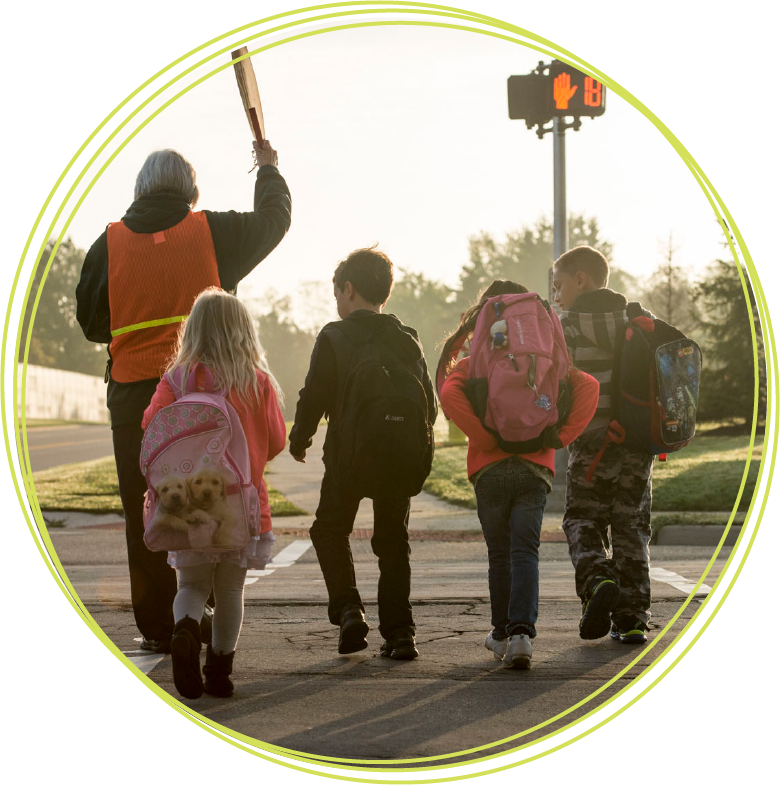 The goal of Safe Routes to School is the development of a school-
The goal of Safe Routes to School is the development of a school-
based plan that will increase the safety and number of students walking and biking to school. Schools collect data from students and parents through surveys and also assess the built environment near the school. They use this information to help guide the development of their action plan. The basic steps in the process are:
-
- Register the school(s). Register schools with Michigan Fitness Foundation. Eligible schools must service at least one grade in K-12.
- Designate a SRTS coordinator. The coordinator is encouraged to participate in a free SRTS Training.
- Establish a SRTS team. The members of the team will vary from school to school but should include: students, parents, teachers, a school administrator, and a representative from the local transportation agency (city, village, or county road commission). Other potential team members could include someone from the local planning department, local business leaders, and a local law enforcement official.
- Assess attitudes and behaviors. Schools will survey parents and students to assess their behavior, beliefs, and attitudes regarding walking and biking to school.
- Assess the safety of walking and biking routes. School teams will assess the physical environment around the school and along routes traveled by students to identify obstacless to safe walking and biking.
- Develop a SRTS Action Plan. The SRTS team will review findings from the audits and information collected through student and parent surveys to develop recommendations to encourage and enable students to walk and bike to school safely. The Action Plan will address engagement, engineering, encouragement, and education needs.
- Submit an Application through the MDOT Grant System (MGS). SRTS hosts a federal grant application for major grant funds, managed by MDOT. Once the team goes through the above-mentioned steps of the process, the team can work together to create the application. The application will focus on eligible infrastructure and non-infrastructure priorities of the committee.
District-wide Programs
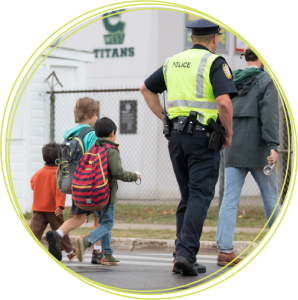 Since 2014, the Safe Routes to School program has encouraged communities to use what we refer to as the “District-wide Approach.” This approach is one that encourages school districts to work as a whole or with multiple schools to develop a comprehensive SRTS plan. Rather than focusing efforts at a single school, communities can work holistically to provide infrastructure and non-infrastructure changes to multiple schools in the community.
Since 2014, the Safe Routes to School program has encouraged communities to use what we refer to as the “District-wide Approach.” This approach is one that encourages school districts to work as a whole or with multiple schools to develop a comprehensive SRTS plan. Rather than focusing efforts at a single school, communities can work holistically to provide infrastructure and non-infrastructure changes to multiple schools in the community.
When starting a district-wide program, it is important to conduct outreach to the local community members and surrounding schools. Many times, SRTS programs will start with a single school or issue and build out from there. Looking at surrounding schools, plus talking at a district level and at the municipal level, can help flesh out the needs of many schools in the community.
District-wide programs can be as large or as small as your community decides. Additionally, it is important to recognize that different schools will have different needs. While one school may need infrastructure changes that require the full planning and application process, another school may solely need programming. The point of looking at a district-wide program is to help identify the needs of many students across the district, develop a holistic program, and institutionalize programs at a district level.
Appendices and How to Use Them
The Michigan Safe Routes to School Handbook appendices cover a wide range of topics to supplement the information listed in this handbook. It may be helpful to scan the appendix titles and consult those appendices which address the questions and needs of your team. A list of resources can be found on our Resources page.
Training and Technical Support
Safe Routes to School training and technical assistance is provided free of charge. For a list of trainings available, please visit our Training page or contact us at 1-800-434-8642.
Starting Out: Walk and Bike to School Days 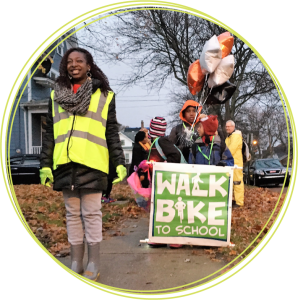
One way to start a Safe Routes to School program in your community is to host a Walk to School Day or Bike to School Day event. Such events:
- Promote the health benefits of walking, bicycling, and rolling.
- Build community support.
- Raise awareness of the safety hazards on the way to school.
School students from around the world participate in Walk to School Day and Bike to School Day events. Walk to School Day takes place the first Wednesday of the first full week of October and Bike to School Day take places likewise in May. Events can be as large or as simple as you choose (or have capacity for organizing).
Ideas for Walk and Bike to School Day
- Walking or Rolling School Bus: A walking school bus addresses the needs of students and the concerns of parents regarding getting to school without supervision. One or more adults accompany a small group of students who pick up other students along a planned route (like a traditional school bus). They walk as a group on their commute to and from school.
- Bike Trains: A bike train is similar to a walking school bus except on bikes. Bike trains are generally used when students are older. To include bicyclists and wheelchair users in Walk or Bike to School Days, plan a bicycle train or rolling school bus or both.
- Alternative Drop Off: In situations where most students are bussed or driven to school because they live too far away, finding an alternative drop-off location for Walk or Bike to School Day is a great idea. Buses and cars can drop off at a designated location a few blocks from school and students then walk with adult volunteers or staff.
- When Routes Aren’t Safe or if Walking is not Possible: When a school cannot hold an event because there are no routes students can safely walk, your school can still participate in Walk and Bike to School Days. “Walk to School Day – at School” is a way to encourage students to get to school by their usual transportation methods but then walk or bike together on a path around the school campus, allowing all students to participate.
- Other ideas: In addition to walking or biking to school as an event, many schools host educational assemblies, pedestrian skill scavenger hunts, bike rodeos, or bike fix-it days at their schools to educate and encourage even more students to walk or bike.
For more ideas, tips, resources on how to host a Walk or Bike to School Day.
Establish a Team and Host a Kick-off Meeting
Jump to following section:
Each school community is unique. The Safe Routes to School team composition and roles reflect the character and needs of the community. When developing the team, work to attract multidisciplinary partners, citizens, and agency representatives to describe how Safe Route to School benefits health, safety, neighborhoods, and education. The awareness of issues which can be dynamically addressed with the collaborative relationships formed as part of the SRTS team is a significant benefit to participation in the SRTS planning process and program.
Team members will work on building local support for SRTS and contributing knowledge and capacity to complete the planning process. Teams may want to think through the tasks that are most important in their community and which team member is the right person to tackle each task. The following outlines the community representation and roles to consider as important parts of a SRTS team working on a planning process.
Core Representation
- Local Transportation Act 51 Agency/Authority (City, Village, County Road Commission, or MDOT)
- The local unit of government that maintains and operates the road network within a defined geographic boundary. They control the roads. These agencies are integral parts of the team since many of the challenges in the physical environment and desired changes are related to the roadway or road right-of-way (such as sidewalks).
- If the school is in a city or village, those agencies likely pay for and maintain the roads.
- If the school is in a township or a rural area, the county road commission is probably the authority; however, townships may also have an interest in roads.
- If the road has an “M” or “U.S.” in front of the road number, or if it is an interstate, it belongs to the Michigan Department of Transportation.
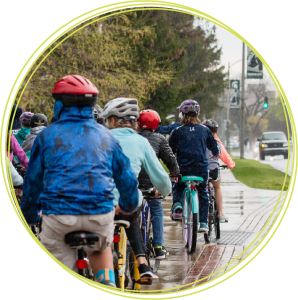
- To reach the appropriate local road authority, use the resource lists for the Michigan Department of Transportation Regional Offices, the Michigan Department of Transportation Service Centers, Metropolitan Planning Organizations, County Road Commissions, Townships, and villages.
- The local unit of government that maintains and operates the road network within a defined geographic boundary. They control the roads. These agencies are integral parts of the team since many of the challenges in the physical environment and desired changes are related to the roadway or road right-of-way (such as sidewalks).
- District-level personnel (superintendent, district transportation director)
- School principal(s) or assistant principal(s)
- Teacher(s)
- Parents
- Students
When working to improve walking or biking to school, it’s important to remember that many problems should be addressed by education and encouragement strategies in addition to, or instead of, engineering strategies. Having a varied group of partners on the SRTS planning team will likely facilitate a more robust public engagement process and a stronger application. Based on the context of your community, you may want to encourage and engage with an expanded list of partners.
Expanded Team Representation
- City or regional planner
- City or village manager
- City council member or elected official
- City or county recreation specialist
- City or county public health official or educator
- Local law enforcement
- Trail or bicycle group representative
- Neighborhood association or block club member
- Faith-based group
- Local nonprofit agency
- Local service club or other charitable organization
- Member from an existing community health, local non-motorized team, or task force
- Other representative from a larger community team or task force of key partner groups
Roles
Champion
It is essential to have a Safe Routes to School champion. This person is passionate about SRTS and determined to advance SRTS objectives. This person often acts as the lead spokesperson for the initiative and should be comfortable talking about SRTS when asked to do so. This champion’s passion galvanizes the school community and inspires citizens and community leaders to join the Safe Routes to School movement.
Team Leader
It is essential to have a SRTS leader. This person is an organizer and makes sure that the team meets regularly and that members are kept informed on activities. This team leader may or may not be the same person as the SRTS champion since the skills needed for these two roles are quite different. The team leader is critical to making sure that planning and follow up occurs. It is great to have co-leaders who can share this role.
Team Members
Team member roles depend largely on the community setting and stem from the information learned from surveys and route audits. However, each member has an opportunity to share in the fun and the challenges of creating a Safe Routes to School initiative in their community. Examples of team member involvement include:
- Organizing a parent outreach event to discuss parental concerns and how SRTS education activities can be part of the solution.
- Coordinating with the Michigan Department of Transportation and the local transportation agency.
- Overseeing the work with the district to modify a parking lot to be safer.
- Developing a communication and media relationship plan to foster community awareness.
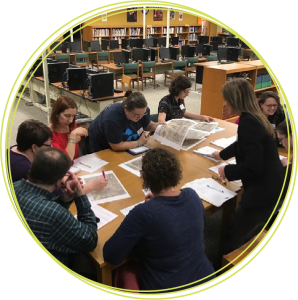 Hosting a Kick-off Meeting
Hosting a Kick-off Meeting
After identifying the initial SRTS team members, gathering the team to discuss and strategize what Safe Routes to School would look like in your community comes next. The purpose of this meeting is to get everyone on the same page about the action planning process and how various partners play different roles in that process. We recommend that a SRTS grant coordinator from MFF facilitate, help organize, or at least attend, this kick-off meeting, especially if it is the first time you’ve pursued a SRTS action planning process.
Set Up the Meeting
Select a kick-off meeting location and time.
Meet partners at a time or location that is convenient for them, especially the parents. A school or community center may be an easy location, but if you’re trying to garner support from another group, it may be more effective to go to them.
Send out Safe Routes to School invitations to parents and community partners.
Think through the communication pathways that partners use and the timing of when you will send the invitations out to position your invitation for higher visibility.
Set the agenda.
Have an intended plan for what will be covered in the allotted meeting time. Refer to the Facilitating a Kick-Off Meeting section (below) for guidance on content which may be good to cover during your meeting.
Set a schedule to carry out Safe Routes to School activities.
The schedule should allow enough time to distribute surveys, analyze the data, conduct walking and biking audits, and reflect on the existing obstacles and potential solutions identified from what the team learns.
Consider available funding options.
While the costs of construction are covered by the SRTS grant, the costs of preliminary engineering (design), construction engineering, permits, and grant administration will need to be covered.
Communities may host their own kick-off meetings, but they are encouraged to contact their Safe Routes to School grant coordinator to request assistance in facilitating.
Facilitating a Kick-off Meeting
Summarize Safe Routes to School.
Go over the mission, funding opportunities, and application process. It may be helpful to provide attendees the Getting Started Handout provided on our Getting Started page.
Discuss the roles of a Safe Routes to School team.
Talk about the roles needed on a SRTS team and get to know the various partners to learn what kinds of knowledge and experiences they bring to the group. Determine which roles and responsibilities would suit each member. Highlight how these different parts come together in the development, planning, and implementation of Safe Routes to School.
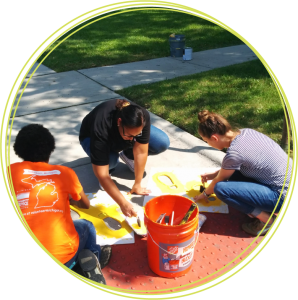
Conduct visioning process.
Invite participants to share their visions of how their community will change with programming. Record general impressions and specifics about how they see Safe Routes to School taking shape in your community. Encourage attendees to think about various strategies for change such as engineering, encouragement, and education.
Think short- and long-term.
Break the proposed ideas into short-, intermediate-, and long-term goals for the community to work toward. Make sure you identify short-term wins which help foster support for SRTS in the community and act as successes to celebrate as a team. Identify how short- and long-term goals fit into the larger SRTS planning process.
Schedule the next steps.
Set a time for a follow-up meeting for team members to touch base and report back on progress since the kick-off meeting. Make sure team members have a clear understanding of their responsibilities and of any deliverables they need to complete before the next meeting.
Tips for Success
- Decide who will organize an agenda for each meeting and what the meeting schedule will be.
- Send meeting reminders to all members even if they can’t make the meeting. Certain notifications should go to the expanded team for events or key activities such as audits or action planning meetings.
- Revisit the goals of Safe Routes to School and the visions generated by the team earlier.
- Share the workload. Delegate tasks and responsibilities according to team member strengths and roles.
- Respect everyone’s vision and contributions by showing appreciation and celebrating small and large victories.
Surveying Attitudes and Behaviors
Jump to following section:
Collecting information about what parents and students already think about walking and biking to school is a crucial early step in the action planning process before the program is implemented. This process has several purposes:
- Establishes baseline data about how students get to and from school.
- Identifies the level of awareness and support for Safe Routes to School.
- Highlights how students would most prefer to get to school and what they believe would make walking and biking better.
About the Surveys
The attitudes about, and behaviors related to walking and biking to a school are collected with three ready-to-use surveys:
- The student data is collected in the computer lab via an online survey.
- The parent data is collected through an online or take-home survey.
- The travel tallies are collected in the classroom by the teacher and entered.
You can obtain sample survey tools to review by contacting Michigan Fitness Foundation main office.
Steps to Set Up Surveys
- The SRTS coordinator or contact should work with the school principal to determine the best time to open surveys.
- The SRTS coordinator, contact, or principal should then work with your grant coordinator to identify that you are ready to open the surveys.
- The operations coordinator will then open the surveys and send the SRTS coordinator and principal the links, instructions, and additional information as requested.
- Surveys due dates can be extended as needed.
Strategies to Achieving a Good Response Rate
Achieving a high response rate is important for the planning process because it helps to more accurately capture the needs and concerns of the whole school (instead of letting a few responses be the voice for everyone). However, getting a high response rate can be difficult due to survey fatigue and the abundance of things competing for people’s attention.
|
MFF staff will work with you to identify the best practices to obtain an appropriate response rate. This strategy may include the use of staff meetings, school newsletters, assemblies, parent-teacher conferences, or other school events to build excitement about forthcoming surveys or to administer surveys. Let parents and students know how the information they provide will be used and that their input matters. |
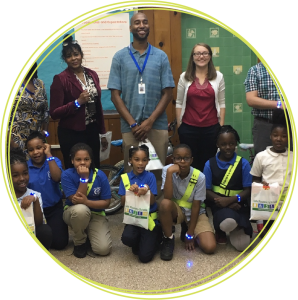 |
Accommodating Different Languages
Capturing the needs of families served at a school is an important aspect of the action planning process. This includes the needs of families where English is not their first language. The SRTS program will continue to make reasonable accommodations to include as many community members in the action planning process as possible. We ask that you please contact MFF if you need a parent survey in another language. Your grant coordinator will work with you to identify the options for those surveys.
Paper Copies and Entry
We acknowledge that some communities do not have access to internet to conduct their surveys online. We can provide paper copies of the survey tools upon request. Responses to the paper surveys will need to be entered using the survey links provided by the operations coordinator.
 |
Please contact the operations coordinator to discuss your data entry needs. Michigan Fitness Foundation may be able to aid your team with data entry if current staffing allows and ample time is provided to make arrangements. |
District-wide Coordination of Surveys
The operations coordinator at Michigan Fitness Foundation coordinates with a community’s team to distribute the surveys. For communities pursuing a district-wide approach, coordinating the proper distribution of surveys needs to be considered. Each school gets its own designated set of surveys so that action plans can be developed for each school’s specific needs.
Please provide either one point of contact who will be coordinating with each school’s point person or the contact information for each school’s point person to ensure that staff, students, and parents are administered the various surveys at the proper time.
Interpreting and Using Survey Data in the Planning Process
Data from the surveys are used to identify issues in your community that can then be addressed to foster a shift for walking and biking to become safer. Examination of the results takes place after all the surveys have received a response adequate for a survey report to be drawn from the Safe Routes to School survey databases
With a vision of where the community wants to be and an assessment of where it currently stands, the data are meant to spur early conversations about what course of action could be taken within the next several months, few years, and long term.
There are various aspects of each report which may warrant specific examination for action planning:
Parent Surveys:
- Improvements significant to parents who do or do not give permission to their children to walk and bike to school provide tremendous insight as to what they perceive would make it better.
- Addressing concerns identified by parents who already grant permission may offer immediate and consistent increases in students using active transportation. Encouraging families who are early adopters of walking or biking may increase the visibility of the program with other families.
- Addressing improvements identified by those parents who do not currently grant permission may be best set as intermediate- or long-term goals.
- When looking at the parent survey reports, pay specific attention to recurring themes and to specific points of concern to address as part of the planning process using the SRTS Es.
Student Surveys:
The student survey questions will also be examined because, while parents often make the final decision to allow their children to walk or bike, it won’t become a consistent behavior unless the student wants to participate.
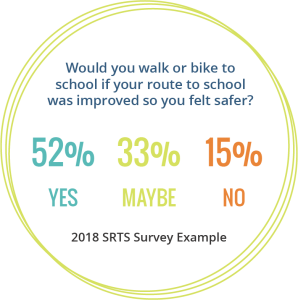
- The questions about how students got to school the morning of the survey or in good weather is a great benchmark. A SRTS program can focus on building momentum when there are some students already walking or biking.
- How students would most like to get to school, if they had a choice, can guide your team toward what kind of encouragement programs should be considered.
- The percentage of students who would walk or bike if it were safer highlights a potential shift towards selecting a healthier way to get to school. Determining what would make walking and biking a fun and desirable option are important points in building a program.
Travel Tallies:
The travel tallies indicate current walking and biking activity before and after school. These tallies can demonstrate the current use and need for programs such as safety education. Walking or biking through inclement weather may highlight the need to use active modes of transportation by a portion of the school’s students. Information like this can help you think of incentives and materials that could be utilized in various weather situations.
Disseminate the Information Collected
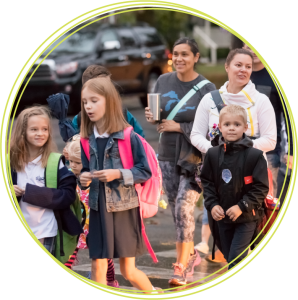 Report the general findings from the surveys back to the students, parents, and school staff who took time administering or sharing their thoughts on surveys. Further, think of partners you plan to engage in the future. You may want to adapt your key message or findings based on that audience. When communicating the information you are highlighting from the reports:
Report the general findings from the surveys back to the students, parents, and school staff who took time administering or sharing their thoughts on surveys. Further, think of partners you plan to engage in the future. You may want to adapt your key message or findings based on that audience. When communicating the information you are highlighting from the reports:
- Think about using the communication channels the team originally solicited for input as well as other spaces which could give exposure to the findings.
- Focus on ensuring that the audience knows their insights are going to good use.
- Think about how you have seen data displayed for easy understanding. Try to emulate it.
- Focus on the findings that will connect with the audiences’ core values and that highlights the importance for why Safe Routes to School programming would be important to them.
- Use the opportunity to allow community members to expand on what is stated in the findings.
Auditing Routes
Jump to following section:
The purpose of completing audits of walking and biking routes is to assess the physical conditions within a one- to two-mile radius around a school. Audits develop a list of infrastructure improvements and are a powerful way to show people why Safe Routes to School is needed.
While this section will guide you through the process of planning and conducting an audit, grant coordinators from Michigan Fitness Foundation are available to facilitate and provide additional support outside of what is described in this section.
Setting Up the Meeting
- Schedule a Date and Time for the Audits
- Choose a time which allows attendees to observe pick-up or drop-off times or both.
- An after-school time may permit students to join and provide unique feedback and perspectives about routes. Additionally, auditing routes during after-school hours is more likely to capture poor lighting conditions along a route.
- Where your community is located may encourage you to audit routes at different times of year to see how obstacles change between months for factors like snow removal.
- Reserve a Meeting Space
-
- Having a meeting space for the audit is helpful to get organized, go over the types of obstacles to look for on the audit, and divide up the routes.
- Ensure that the space is reserved long enough to function as a place to gather after routes have been audited so the whole group can debrief about their experience and next steps.
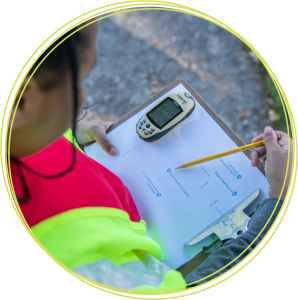
-
- Send Invitations and Publicize
- Think beyond your core team of parents, staff, and representatives from your Act 51 agency. Reach out to the school board, student representatives, neighborhood associations, city council, or local government officials.
- Publicize the event through different networks to extend your reach. Reference the Media Kit on our website for an example press release to publicize your planning events.
- This event is a great opportunity to galvanize the community behind the need for Safe Routes to School as extended team members experience what it means to be a student traveling to and from school.
- Gather What You Need
- Have the forms on hand to capture how the audit functions to engage the public in the planning process and assess the condition of the built environment near the school and surrounding area.

- Have a sign-in sheet to track who attended this meeting.
- There are various audit forms, guides, and resources available on our Walking Audit page to use to assess a school site and routes. Forms vary in their focus on facilities for pedestrians, bicyclists, or both. While all pedestrian and bicycling audit forms incorporate considerations for the American Disabilities Act, you can get audit forms designed to help the SRTS team consider specific challenges and circumstances that students with disabilities face when using active transportation. Contact an MFF grant coordinator for more information.
- Provide clip boards, pens, and high-visibility vests to help the extended team members and volunteers help you collect the data on the audits.
- Obtain small maps of the routes and areas surrounding the schools. See the next section
“Selection of Routes” to determine what you will need for your community. - Provide refreshments and childcare, when possible, to community participants who attend. Such considerations may encourage a larger portion of the group to stay for the duration of the debriefing and demonstrates appreciation for those who may have walked through hot, wet, or cold conditions outside. Childcare may make it possible for some members to attend when they otherwise couldn’t.
- Have the forms on hand to capture how the audit functions to engage the public in the planning process and assess the condition of the built environment near the school and surrounding area.
Selection of Routes
Maps at the audit event serve a few different purposes. They can:
- Illustrate the larger process of how data are collected to inform the priorities for which funding is being pursued.
- Identify route options for walking and biking between where students live and the school(s).
- Indicate where a hazard or obstacle on the route occurs.
Student Home Maps
- Directing the largest number of students safely from their homes to school by walking or biking starts with determining where students live. A map of the home areas of students provides important information for the team to effectively select routes.
- Your grant coordinator at Michigan Fitness Foundation can create a
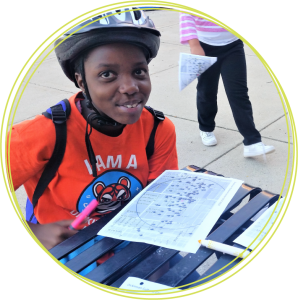 student home map for you. Michigan Fitness Foundation staff needs a list of the student addresses without identifying information to generate a map. A list of student household addresses can usually be obtained from your district office if your school district can’t provide the mapped areas of student home.
student home map for you. Michigan Fitness Foundation staff needs a list of the student addresses without identifying information to generate a map. A list of student household addresses can usually be obtained from your district office if your school district can’t provide the mapped areas of student home.
Route Maps
- The SRTS team may have determined routes to audit before the event or may be waiting for the audit day to determine routes based on participant input. When using the latter approach, bring enough large and small maps to draft various routes, provide specific route paths to each group, and have a clean route path to record the location of identified hazards.
- To draw on the local expertise of the group while also making the route selection more engaging for attendees, ask probing questions such as where use exists or where participants have seen dangerous walking or biking behaviors getting to or from school.
- Maps of a larger size may be needed for bicycle audits to allow enough space for longer distance routes.
Other Informative Maps
- It may be worth checking to see if any maps are available from local officials, public works departments, or local MDOT Transportation Service Centers. These maps may provide a good overview of the larger area and how existing routes cover various portions of your community. Regional, local, and municipal non-motorized plans and maps can inform the team about features which could be incorporated into the SRTS plan.
The Audit Event (Estimated total time 1.5 – 2.5 hours)
- Welcome to the Audit (5–10 minutes)
- Go over the general mission of Safe Routes to School and have attendees introduce themselves and their role.
- Discuss Common Safety Hazards on Routes (5 minutes)
- Distribute the lists of What to Look For, which can be found on the Walking Audit page, and quickly go over how they impact safety.
- Select and Review Routes (5–10 minutes based on pre-selected routes or not)
- Break into Groups (5 minutes)
- Allow attendees to self-select their group based on the route(s) of most interest to them.
- Strive to achieve even groups with at least two people (to serve as the recorder and photographer).
- Spread the individuals with engineering and planning expertise amongst the groups when possible.
- Audit Routes (40 minutes – 1.5 hours)
- Send groups out to audit with and expected return time for debriefing as a group, which should be based on the route distances.
- The bike audit can happen concurrently as the walking audits or at a separate time by one or multiple people.
- Debrief (30 minutes)
- Have each route group share with the group at-large their overarching impressions and the top three priorities identified along their route. Discuss and envision solutions for immediate and long-term consideration.
- There are several helpful prompts to use during the debriefing:
- What problems did you find?
- What are your highest priority issues?
- What initial recommendations do you have? What short-term treatments can you implement now?
- Explain next step details for summarizing and consolidating data as well as the larger grant process.
- Set Date(s) for Action Planning Meetings
- Schedule a meeting which accommodates the availability of partners who were able to attend the walking audit as well as those who weren’t. Make sure to refer to the next steps below to go over follow-up items to be completed after an audit and the next section on “Completing an Action Plan” to review how action planning meetings can be structured to meet your team’s goals.
Next Steps
- The first thing a team should do after an audit is consolidate the information collected along the various routes into something usable for the action planning meeting(s). There is no single prescribed method for accomplishing this, but it may prove useful to set up a shared online folder where summaries of the audit forms and photos can be gathered. From there, you’ll want to align the pictures with descriptions of the hazards and pull out the information about the priorities identified on each of the various routes.
- In addition to analyzing the audit data, communities may need to move toward different next steps based on the context of their audit findings. Some communities come away from a walking audit driven to review and assess the needs of alternative route options for walking and biking beyond what was covered during an initial walking audit. This approach may hold particularly true for communities pursuing a district-wide application. Other groups find that the initial audit provided the information about the physical obstacles they need, but that additional information is still needed such as who owns the properties adjacent to areas identified for improvement or the existence of easements for pathways.
- The core team should work with their grant coordinator to determine what follow-up is needed to make the most out of the future action planning meeting.
Completing an Action Plan
Jump to following section:
The purpose of completing an action plan is to identify the key steps to support more walking and biking among your students. The process of prioritizing objectives and establishing a timeline to keep team members accountable turns the Safe Routes to School vision of the community into manageable goals supported by public input and data.
An action plan is meant to serve as a living document for a community. It should be revised as your community builds momentum, reaches achievements, or identifies new barriers to increasing walking or biking as transportation to school.
Format of the Meeting(s)
- Action planning meetings should be structured to accommodate the team’s preferences and needs. They can be formal, information-driven sessions with PowerPoint presentations to recap survey and audit findings. Or, meetings can focus on gaining more input and gauging community support for brainstormed solutions using flip boards and dot surveys.
- A community may choose to cover the full approach to creating a Safe Routes to School Action Plan in a single meeting or schedule multiple meetings where each would cover focused aspects of Safe Routes to School.
District-wide Considerations
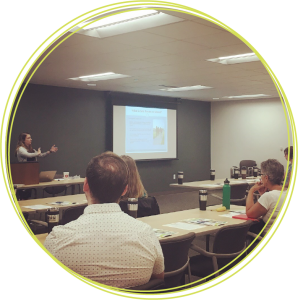 Breaking up meetings into manageable pieces is a recommended approach for district-wide planning. Meetings can be organized either by school or by the type of SRTS component to be discussed — infrastructure and non-infrastructure.
Breaking up meetings into manageable pieces is a recommended approach for district-wide planning. Meetings can be organized either by school or by the type of SRTS component to be discussed — infrastructure and non-infrastructure.
- The school-based approach can help a team focus on the information specific to each school’s needs, allowing the team to consider all the program components and how they work together to increase walking and biking by students at each school.
- The infrastructure and non-infrastructure component approach can streamline the information covered at each meeting. Additionally, this approach can reduce the total number of meetings, which may minimize the demands on certain team members to attend multiple sessions and may optimize their attendance when they are needed. This approach can reduce redundancy of objectives created at school-focused action planning meetings and provide a better overview of the scope of work across the district.
- An overarching district-level meeting is encouraged with both approaches. It can help the team review the program from multiple perspectives and fine tune the Es in the action plans to ensure a quality, cohesive SRTS plan across the district.
Who to Invite
- The format and content being covered at the action planning meeting(s) should indicate who should be invited. It may not be necessary to have the extended team at each meeting. Invite field experts to participate as needed to help recommend specific and feasible solutions. These experts may include engineers, educators, or law enforcement officers. Refer to the section on “Establish a Team and Host a Kick-off Meeting” for ideas on who should be involved. Make sure to have the local transportation agency and school(s) represented at the final overview meeting to ensure that both parties agree and have clarity on the final action plan’s goals, objectives, and next steps.
Examples of the Es: Engagement, Engineering, Encouragement, Education,
& Evaluation
The action plan should be guided by the data collected and should incorporate the Es to provide a comprehensive approach to behavior change. Revisit the definitions of the Es and how they work to support safe walking and biking by referring to the “Welcome to Safe Routes to School” section. The examples below illustrate ways each “E” could be approached when filling out the Action Plan Form. These examples may not fit your community’s context or needs, but they are meant to broadly illustrate how other communities have used the Es to identify important aspects of a Safe Routes to School program. More examples can be found on our Getting Started page.
- Engagement
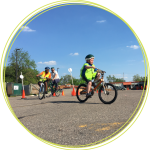 Foster intentional participation opportunities for students with abstract visioning exercises or prompts for students to illustrate and describe what a safe walking or biking experiences look like.
Foster intentional participation opportunities for students with abstract visioning exercises or prompts for students to illustrate and describe what a safe walking or biking experiences look like.- Develop ongoing relationships with parents and partners in small and large ways such as reporting back on progress made on the SRTS action plan and creating leadership opportunities for events or parts of the process.
- Conduct an asset mapping exercise to identify partners outside of those identified as part of a core team. Initiate conversations with these partners about their connection to SRTS and active transportation more broadly.
- Schedule SRTS planning meetings to enable participation from community members and offer childcare during meetings so that more people can participate.
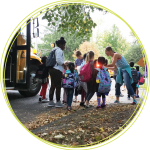
- Engineering
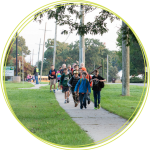
- Change the design of roads, sidewalks, and other infrastructure connecting residences to schools to be safer for students to learn, practice and gain comfort with employing safe travel behaviors.
- Keep the sidewalks clear of hanging branches which may not be detected by persons with visual impairments.
- Encouragement
- Create contests between classrooms or schools with incentives to motivate students.
- Start an incentive program with tokens or punch cards to earn raffled prizes.
- Select prizes that are supportive of increasing safety, such as lights, gloves, and helmets.
- Host special events such as bike fairs or walking events to motivate and test active transit knowledge and skills.
- Reward parents who follow the school’s drop-off and pick-up rules.
- Education
- Incorporate bicycle and pedestrian curricula in schools for students (across the whole school with grade variation).
- Make resources available to families about the location of remote stops, information aobut bike maintenance, or proper uses of helmets.
- Organize family rides and bike rodeos to reach parents and guardians as well as students.
- Evaluation
- Consideration and incorporation of community input and baseline data collected in the planning states from surveys, tallies, and audits.
- Track and adapt your program over its implementation by reviewing data during program delivery to improve program quality and participation.
Running an Action Planning Meeting
- Welcome and overview of SRTS
- Restate the goal of the Safe Routes to School program and the community or schools’ general objectives for a Safe Routes to School program.
- Make Introductions
- Attendees should introduce themselves, their reason for getting involved, and their role in the process.
- Review Baseline Data Collected
- Share the survey highlights and distribute a report of responses if one was created.
- Review the recommendations from the walking audit, bike audit, and school property assessment.
- Go over any additional community input or summaries from prior Action Planning meetings.
- Brainstorm and Prioritize Solutions
- Brainstorm and identify potential solutions to the obstacles identified while reviewing the baseline data. Think about short- and long-term objectives:
- Short-term ideas which can quickly be started to generate easy wins for the program and
community. - Long-term plans which may take more collaboration and formative groundwork to get started or implemented.
- Short-term ideas which can quickly be started to generate easy wins for the program and
- Brainstorm and identify potential solutions to the obstacles identified while reviewing the baseline data. Think about short- and long-term objectives:
- Complete the Action Plan Form
- Think through who is needed to work toward each initiative. Assign specific team members or groups to be responsible for coordinating and implementing each part of the program.
- Think through the funding of the Action Plan.
- Work with your grant coordinator to determine which components of the plan would be eligible for a SRTS grant if funding is needed. Refer to our Infrastructure & Non-Infrastructure Eligibility page for details. If any components of the plan are ineligible for funding through a SRTS grant, identify other funding or partnership sources to reach the objectives.
After the Action Planning Meeting
- Develop the action plan by working with your SRTS grant coordinator.
- Circulate the plan to key partners. Seek feedback and approvals, such as resolutions from the Act 51 Agency or support from the school board, to proceed. Modify the plan as needed.
- Review funding and grant options as needed.
- The SRTS planning process is open to all communities regardless of whether they intend to apply for SRTS funding.
- Communicate to your grant coordinator your team’s intention to apply for SRTS funding and which SRTS application cycle the team is aiming to apply within. Refer to the Major Grant page for the application schedule.
- Apply for Safe Routes to School funds by submitting a TAP application on the MDOT Grant System. Refer to our Submit a Major Grant Application page for details, the SRTS Major Grant Supporting Documents page templates, and the TAP Application Guide.
- Communicate with MFF staff as the application moves through the review process. Respond to any inquiries or requests for supplemental information needed to make the application more competitive.
- The Action Plan can be used as a good starting point to develop a Statement of Need to apply to other funding sources outside of SRTS. Use the Action Plan or its framework to show support for, and the existence of work toward, shifts for healthy changes in your area.
- Start mobilizing for the easy wins identified during action planning.
- Review the plan at regular intervals. Celebrate successes and adjust objectives and timelines as appropriate.
- Have a party or fun walk to celebrate SRTS!
- Keep SRTS alive with Walk & Bike to School Day each year. Refer to “Starting Out: Walk and Bike to School Days” section and our Programs & Events page for more information.
Handbook Appendices
FAQ
Who can apply for funding?
SRTS teams may apply for two kinds of funding: mini grant programmatic funds and major grant infrastructure funds. Eligible recipients for SRTS mini grants include local agencies, nonprofit organizations, schools, and school districts. A local transportation (Act 51) agency must be the applicant for major grant funds from MDOT. A SRTS team must complete the planning process outlined in this handbook before applying.
How long does it take to apply for a major grant?
It typically takes anywhere from six months to one year for an interested community to go from the kick-off meeting to an application submission, depending on the local capacity to prepare the application, the complexity of the design engineering, and the geographic context of the work
being proposed.
What are the costs associated with applying to this program?
Safe Routes to School funding is 80 percent federal; a 20 percent local match is required by federal law. The minimum of a 20 percent match is at this time being covered, effectively making SRTS applications require zero percent match. While this is true currently, it is feasible that this may change in the future. Check with your grant coordinator to inquire about the most updated information regarding SRTS match requirements.
Additionally, a certain amount of preliminary engineering (design) is needed prior to application submission and construction engineering during the infrastructure implementation process. Communities should expect preliminary design engineering (PE) to be an average of 20-30 percent of the construction costs of a project. Engineering costs are not eligible for grant funding.
Who pays for preliminary design engineering (PE)?
Costs associated with permits, project administration, and preliminary design engineering (including, but not limited to, inspection, staking, and material testing) are not eligible for reimbursement and are the financial obligation of the applicant.
Why can SRTS funds only be used for K–12 grade students?
The federal Safe Routes to School program parameters are intended for elementary through high school students in grades K–12. A school must have at least one grade in the K–12 range to apply for funding. Further, a state’s SRTS share of funding is based on the number of students enrolled in primary, middle, and high schools per year, and the legislative approval for SRTS is focused on serving students within these grade areas.
Is there a community I can talk to which is like ours that has successfully applied and been funded?
Please contact your grant coordinator if you’re interested in identifying a similar community. MFF staff can help you identify a community which may be similar in context.
How frequently must a school conduct education or encouragement programs that support students walking or biking to school to qualify for funding?
Program frequency varies by community. Many schools start with a goal of a monthly walking school bus and work their way to weekly walking school buses or more. The goal for how frequently students are walking should be driven by setting realistic goals based on pre-existing walking behavior and the needs of the students.
Can we hire a SRTS program coordinator?
SRTS programs can hire a SRTS coordinator for implementing non-infrastructure programming. These positions are to be paid with an hourly rate that follows the grant’s eligibility requirements. Positions may not be paid as a stipend.
Another option to hiring a SRTS coordinator is designating funds to pay existing volunteers an hourly rate.
What is the difference between a crossing guard and a corner captain, and how can these be funded through SRTS?
In Michigan, crossing guards have a legal authority to stop traffic that is designated to them by the local law enforcement unit, whether that is a sheriff’s department, local police department, etc. Even if the position itself is funded via a school or even outside agency, they still must be authorized by the local law enforcement agency.
Corner captains are meant to be more of a friendly face on the way to school, serving as a stationary route leader. They are not allowed to stop or impede traffic for students to cross an intersection.
SRTS cannot fund crossing guard positions as it is an ineligible expense within our program. However, the program can fund equipment and training for crossing guards. The SRTS program can fund corner captain positions if they follow the hourly rate requirements.
How does a team build an effective SRTS coalition or partnership?
Building a varied team with a range of partners who understand SRTS programming can bring about multifaceted benefits and is fundamental for an effective SRTS coalition. A best practice is to work toward formalizing the team’s relationships with periodic meetings and opportunities to collaborate on relevant and current concerns which impact SRTS programming. This formalization helps the group share resources, become more resilient, and stay adaptive to the needs of students walking and biking to school.
The awareness of issues across SRTS partners and relationships formed during the SRTS action plan process are significant benefits to participation in the SRTS program.
Rural transportation issues are different from urban and suburban contexts. How does SRTS apply to rural communities?
The SRTS planning process is adaptive for each community to identify the issues and potential solutions which are relevant to their area’s context. Infrastructure and non-infrastructure projects are chosen through the planning process to help meet the specific needs identified within a community.
SRTS Funding
SAFETEA-LU
Safe, Accountable, Flexible, Efficient Transportation Equity Act for the 21st Century for Users was the funding authorization and authorization bill that governed United States federal surface transportation spending. It was signed into law by President George W. Bush in 2005 and expired in 2009.
This created the statutory purposes for the federal Safe Routes to School program, which are:
- To enable and encourage children, including those with disabilities, to walk and bicycle to school;
- To make bicycling and walking to school a safer and more appealing transportation alternative, thereby encouraging a healthy and active lifestyle from an early age; and
- To facilitate the planning, development, and implementation of projects and activities that will improve safety and reduce traffic in the vicinity of schools.
MAP-21
In 2012, the Moving Ahead for Progress in the 21st Century Act (MAP-21) was signed into law. This legislation authorized federal transportation programs and funding levels for fiscal years 2013 through 2014. MAP-21 differs from the previous Act (SAFETEA-LU) in that Safe Routes to School and a few other programs are combined under what’s known as the Transportation Alternative Program (TAP).
As a result of the MAP-21 legislation, states could choose whether to fund the Safe Routes to School program to help with infrastructure improvements and non-infrastructure activities to encourage and enable students to walk and bicycle to school. Michigan made a clear choice to support the Safe Routes to School program proportional to the other programs within TAP.
FAST Act
The passing of the Fixing America’s Surface Transportation Act (FAST Act) by Congress in December 2015 maintained funding from MAP-21 for five more years. Funding for TAP changed from $819 million per year to $835 million in 2016 and 2017 and to $850 million in 2018 through 2020. As was part of the MAP-21, TAP requires a competitive process in which local governments apply for projects. Under the FAST Act, state and local nonprofit organizations that work on transportation safety can compete directly for TAP dollars.
Bipartisan Infrastructure Law
Congress passed a five-year transportation bill in November 2021 titled Infrastructure Investment and Jobs (IIJA) or Bipartisan Infrastructure Law. SRTS continues as a category of the Transportation Alternatives Program (TAP). SRTS activities are now eligible for K-12 grades (formerly K-8) for funding under TAP.
Other program parameters as issued by Federal Highway Administration or the Michigan Department of Transportation are listed below:
- The federal Safe Routes to School program is for students in grades K–12. A school must have at least one grade in the K–12 range in order to apply for funding.
- Eligible recipients include state, local, and regional agencies including nonprofit organizations.
- Funding is 80 percent federal; a 20 percent local match is required.
- Infrastructure projects must be constructed within a two-mile radius of the school.
- Costs associated with permitting, project administration, and preliminary engineering (design), and construction engineering (including, but not limited to, inspection, staking, and material testing) are not eligible for reimbursement and are the financial obligation of the applicant.
Michigan Fitness Foundation
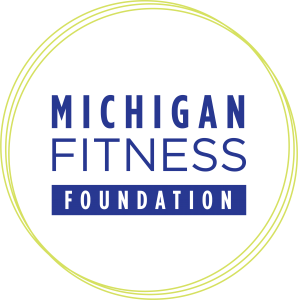 |
The Governor’s Council on Physical Fitness was established in 1992 to improve the health of, and increase physical activity among, Michigan residents. Michigan Fitness Foundation (MFF) was created in 1994 as a 501(c)(3) nonprofit foundation to carry out the Governor’s Council’s policies and programs and to provide a broader funding base to pursue its mission of Getting Michigan Moving. |
Mission
Michigan Fitness Foundation and the Governor’s Council on Physical Fitness, Health and Sports are working to improve the health of Michigan citizens by promoting the health benefits of physical activity and by creating behavior-change programs that equip Michigan citizens to lead healthy lifestyles. The Council and Foundation are focused on preventing chronic disease and reversing the trend toward sedentary living.
The Foundation focuses on active communities, health programs, and educational program plus marketing and outreach. Programs are designed to foster and facilitate healthy choices.
Safe Routes to School in the mission and work of Michigan Fitness Foundation
Safe Routes to School works to create and support places where it is easy to be physically active for students going to and from school. The program areas at MFF outside the SRTS program that support the vision of healthy lifestyles for Michigan citizens include:
 |
The Michigan SNAP-Ed helps partners provide nutrition education to SNAP-eligible families by empowering individuals to gain knowledge and access to resources that help them integrate healthy eating and physical activity into daily life. |
 |
The Promoting Active Communities (PAC) program is an online assessment and action planning tool available at activecommunitytool.org. It helps communities identify local obstacles to active living and equips them with feedback, best-practices, and action planning tools to make changes that support active living. |
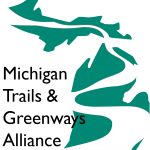 |
The Michigan Trails and Greenways Alliance (MTGA) focuses on creating and supporting change to make it easier to be physically active through active transportation trail networks- helping people build, connect and promote trails for a healthier and more prosperous Michigan. |
In addition to the programs at MFF, the SRTS program has network partners which help us to deliver more valuable services to communities as well as expand the opportunity and reach of Safe Routes to School across Michigan. Learn more about them on our Network Partners page.
Trails as Safe Routes to School
Found throughout Michigan, in both rural and urban landscapes, are more than 2,000 miles of off-road, multi-use trails for walking, biking, and other non-motorized modes of transportation. While most people tend to think of these as recreational paths, they can effectively serve as main arteries in a Safe Routes to School system provided they are designed for safety and primarily aligned between the school and where people reside.
If no trails exist in the area, there are a variety of land uses which could accommodate a new trail. This checklist delineates the safety features that are needed for multi-use trails and the first steps to take in determining feasibility for a new trail.
Existing Trails
If a hiking or biking path exists within a two-mile radius of the school and is in alignment between the neighborhoods and the school, you should first assess its safety. Today, there are safe design requirements to get public grant funding, but older trails or those built entirely with private funds may not be in complete compliance with these standards.
In the case of older trails, a public grant for rehabilitation of the surface will help you to bring it up to today’s standards. For privately-built trails, you should assess whether the lack of a certain feature puts users at substantial risk that warrants remedial action.
Many of the same features a community would be looking for on a walking audit would need to be considered for trails:
- Safe crossings at road and trail intersections
- Drainage features
- Smooth, well maintained, and debris-free surface
- Line of sight
- Connections to the trail
- Bridges and underpasses with vertical clearance and clear width
- Wayfinding
New Trail Potential
here may be potential for a new trail if there is a park, drainage corridor, utility easement, or land in public control or ownership that is naturally aligned between neighborhoods and the school. You should check with the local tax assessor’s office to find out whether the land of interest is in public control or ownership. They will have parcel maps indicating land ownership.
The public land you are evaluating for a trail should have at least 20 feet width of relatively dry and level right-of-way and as few driveway crossings as possible to avoid interface with traffic.
Identify your non-motorized transportation network. The more transportation opportunities created by your proposed trail, the more likely you will be able to secure grant funding. Review your local government’s or region master’s plan related to parks, non-motorized transportation, open space, and overall land use, if available, to see how the trail fits into the overall picture. (Local government plans might be found at a local planning or zoning department.) Ask about proposed projects which could affect the trail corridor of interest, such as utilities, road projects, or future development.
Pay attention to vacant lands and proposed uses. By collaborating with other funders, there may be opportunity to add amenities not eligible for SRTS funding such as parking, restrooms, kiosks, etc., which add value to a SRTS program.
Obstacles:
- High traffic or active railroad crossings
- Dark or isolated areas
- Environmentally hazardous or sensitive areas
- Crossing a natural river
Next Steps
These steps are the same as the SRTS planning process:
- Identify partners who would have interest in, benefit from, or be affected by the trail to hold a preliminary meeting to express views.
- Obtain a map of the route and photograph the good and bad points of the route.
- Develop a vision for the trail to promote and share.
- Tap into resources for assistance (check out the trails section of our Active Transportation Resources).
- Look into hiring a consultant for engineering or landscaping who could facilitate public meetings and answer concerns. They could develop a plan for the trail with work needed for design engineering (PE).
Trails Across Private Land
Most trails are routes on public land. However, depending on the attitude of property owners and other special circumstances, it may be possible to gain an easement across private land. As you strategize about securing a donation, easement, or outright purchase of the land, it is best to build a positive relationship with the landowner early in the project, talking about how to make the trail a “win-win” opportunity.
For more information on the above steps and process contact:
Michigan Trails and Greenway Alliance
Info@michigantrails.org, or by phone at 517-485-6022.
Liability and Safe Routes to School
You may ask yourself, “What liability concerns should a community and school district be aware of when starting a SRTS initiative and how do they minimize that liability?”
While it is good to think about risk and liability as a school district or nonprofit, we hope that the information provided will help alleviate worries about beginning a SRTS program.
To date, there are no known lawsuits involving an injury to a child in an organized SRTS program even with SRTS programs in place at more than 4,500 schools around the country. Concerns about liability are often much greater than actual risks. Common sense precautions go a long way toward avoiding liability risk. In fact, SRTS programs can decrease schools’ liability exposure by addressing hazards systematically. In most states, including Michigan, school districts have meaningful protection against liability through “governmental immunity.”
- Know Your Risk, Talk About Negligence
- The best way to reduce liability is to avoid negligence. Negligence occurs when a person or entity
doesn’t act as carefully as an ordinary, reasonable person would under the circumstances and, as
a result someone is injured or property is damaged.
- The best way to reduce liability is to avoid negligence. Negligence occurs when a person or entity
- Educate Yourself
- Review the state’s legislation on school transportation, governmental liability, and the Federal Volunteer Act.
- Reducing Hazards
- Talk with your administration, governmental legal counsel, or other leaders about liability and reducing risk.
- Take steps to assess your potential programs and the risk those might cause. Think of areas where you can reduce hazards such as working with local law enforcement to discuss traffic concerns, reducing sidewalk hazards, and educating and vetting volunteers.
- Additional Resources
- Review the SRTS National Partnership Fact Sheet on Liability
- Review the “Volunteers and Liability” fact sheet
Case Studies
MFF staff frequently hear from communities that some of the most helpful information to have about the planning process are success stories and examples of how Safe Routes to School has been implemented in other communities.
We develop case studies of a selection of past projects to respond to these requests. These case studies highlight the great work happening across the state. Case studies can be found on the Case Studies page. Please contact our offices if you’re interested if identifying a case study of a community like yours.
Acronyms
| AASHTO | American Association of State Highway and Transportation Officials |
| ADA | Americans with Disabilities Act |
| APBP | Association of Pedestrian and Bicycle Professionals |
| ARC | Application Review Committee |
| CC | Conditional Commitment |
| CIP | Capital Improvement Plan |
| CMAQ | Congestion Mitigation and Air Quality Improvement Program |
| CRC | County Road Commission |
| EDF | Economic Development Fund |
| EPA | Environmental Protection Agency |
| FAST | Fixing America’s Surface Transportation Act of 2015 |
| FHWA | Federal Highway Administration |
| FTA | Federal Transit Administration |
| GIS | Geographic Information System |
| HHS | U.S. Department of Health and Human Services |
| LMB | League of Michigan Bicycles |
| MAP-21 | Moving Ahead for Progress in the 21st Century Act of 2012 |
| MDE | Michigan Department of Education |
| MDOT | Michigan Department of Transportation |
| MGS | MDOT Grant System |
| MFF | Michigan Fitness Foundation |
| MTGA | Michigan Trails and Greenways Alliance |
| MUTCD | Manual on Uniform Traffic Control Devices |
| MMUTCD | Michigan Manual on Uniform Traffic Control Devices |
| MPO | Metropolitan Planning Organization |
| NACTO | National Association of City Transportation Officials |
| NCBW | National Center for Bicycling and Walking |
| NCSRTS | National Center for Safe Routes to School |
| NHTSA | National Highway Traffic Safety Administration |
| OED | Office of Economic Development |
| PAC | Promoting Active Communities |
| PE | Design Engineering |
| PBI | Pedestrian and Bicycle Information Center |
| ROW | Right of Way |
| RPO | Regional Planning Organization |
| RRFB | Rectangular Rapid Flash Beacon |
| RTC | Rail-to-Trails Conservancy |
| SAFETEA-LU | Safe, Accountable, Flexible, Efficient Transportation Equity Act for the 21st Century for Users |
| SRTS | Safe Routes to School |
| SRTSNP | Safe Routes to School National Partnership |
| TAP | Transportation Alternatives Program |
| USDOT | United States Department of Transportation |
| WSB | Walking School Bus |
Definitions
AASHTO Standards are nationally-recognized best practice guidelines for bicycle and pedestrian facility design.
Americans with Disabilities Act (ADA) is a federal act that regulates the building of new structures to ensure that persons with disabilities have equal access. For example, intersections might include curb ramps with a textured surface to forewarn individuals with vision impairment to protect them from entering the intersection unknowingly.
Built environment refers to physical features that have been built by human beings (such as subdivision road networks) and that may or may not encourage walking and biking.
Complete Streets is a transportation policy and design approach that requires streets to be planned, designed, operated, and maintained to enable safe, convenient, and comfortable travel and access for users of all ages and abilities regardless of their mode of transportation.
Connectivity is the linking of streets, trails, sidewalks, and bicycle facilities to form a network for non-motorized travel.
Context-sensitive design is design that takes a community’s location, perspectives, and relationships to its surrounding geography into consideration when planning and designing transportation facilities.
Facilities is a term engineers that use to describe many types of physical structures (such as sidewalks, traffic signals, and bicycle lanes).
Multi-modal refers to a transportation system that supports different modes of travel such as walkways, bikeways, roads, buses, and railroads.
MUTCD is a manual that contains national standards for signs and pavement markings, including markings in school zones. State and local jurisdictions may have their own guidelines.
Remote drop sites are areas where students who live greater distances from the school than would be reasonable to walk can be dropped off to participate in and gain the benefits of walking to school.
School home area is the geographic area where students attending the school live (except for school-of-choice students).
School Traffic Control Plan is a comprehensive school traffic plan that includes signage and pavement markings on streets around the school.
School walking area is the area inside of school home area in which busing service is not provided. Distance to school varies by school or school district.
School zone is the area directly adjacent to a school, (often 1–2 blocks around the school). This is the area where special school signage and marking occur.
Sidewalk buffers are planting strips, parked cars, bike lanes, or street furniture that separate the sidewalk from the road.
Smart Growth refers to development that is environmentally sensitive, economically viable, community-oriented, and sustainable. A smart-growth plan promotes environmental quality, energy conservation, open space and farmland, and strong neighborhoods.
Traffic Calming involves changes in the number of lanes, street alignment (such as traffic circles), the installation of obstacles or speed bumps, and the other physical measures to reduce traffic speeds or cut-through volumes or both in the interest of street safety, livability, and other public purposes.
Transportation Alternatives Program (TAP) is a competitive grant program that uses federal transportation funds designated by Congress for specific activities that enhance the intermodal transportation system and provide safe alternative transportation options.
Vision Zero is a multi-national road traffic safety project that aims to achieve a highway system with no fatalities or serious injuries involving road traffic.
Acknowledgements
SAFE ROUTES TO SCHOOL IS A PROGRAM OF THE MICHIGAN DEPARTMENT OF TRANSPORTATION AND THE U.S. DEPARTMENT OF TRANSPORTATION – FEDERAL HIGHWAYS ADMINISTRATION
SAFE ROUTES TO SCHOOL FUNDING PARTNERS
- Michigan Department of Transportation
- Michigan Fitness Foundation/Governor’s Council on Physical Fitness, Health and Sports
- Federal Highway Administration
SAFE ROUTES TO SCHOOL STAFF
- Michigan Department of Transportation Staff — Refer to the MDOT OED website for current staff
- Michigan Fitness Foundation Staff — Refer to our Contact page for current staff information
SRTS PILOT ELEMENTARY SCHOOLS
Belmont Elementary, Rockford Public Schools
Cherry Creek Elementary, Lowell Area Schools
Clear Lake Elementary, Oxford Area Community Schools Frost Elementary, Jackson Public Schools
Johnson Elementary, Taylor School District
Lincoln Elementary, Cadillac Area Public Schools Stanton Elementary, Central Montcalm Schools
Washington Elementary, Flint Community Schools Webster Elementary, Pontiac School District
Westlake Elementary, Lakeview School District
Winans Elementary, Waverly Community Schools
Copyright
Michigan Safe Routes to School Handbook © 2021 Michigan Fitness Foundation and Michigan Department of Transportation, revised 2025.
ALL RIGHTS RESERVED.
The Michigan Safe Routes to School Handbook (SRTS Handbook) was developed and produced by Michigan Fitness Foundation with funds from the Federal Highway Administration through the Michigan Department of Transportation Transportation Alternatives Grant and Safe Routes to School (SRTS) Programs. The content of the SRTS Handbook is available for not-for-profit general use when: 1) used without alteration, and 2) when proper credit (as stated below) is given to the Michigan Department of Transportation, Federal Highway Administration, and Michigan Fitness Foundation. The design and format of the Michigan Safe Routes to School Handbook may not be used to develop other materials without the permission of the publishers.
Credit to be given must read: “The Michigan Safe Routes to School Handbook was developed and produced by Michigan Fitness Foundation, Michigan Department of Transportation, and United States Department of Transportation—Federal Highway Administration. Contact Michigan Fitness Foundation, P.O. Box 27187, Lansing, Michigan, 48909, www.saferoutesmichigan.org, for copies of the Michigan Safe Routes to School Handbook and for all questions concerning use of the Handbook materials.”
Reproduction, transmittal, or electronic storage of the Handbook for any purpose other than that stated above is not permitted without permission of the copyright holders.
The Publisher and Authors disclaim responsibility for any adverse effects or consequences from them application or injudicious use of the information contained within this text. Inclusion of resources and associations does not necessarily imply endorsement by the Publishers or Authors.
Printed in the United States of America by Michigan Fitness Foundation, P.O. Box 27187, Lansing, MI 48909 1-800-434-8642
